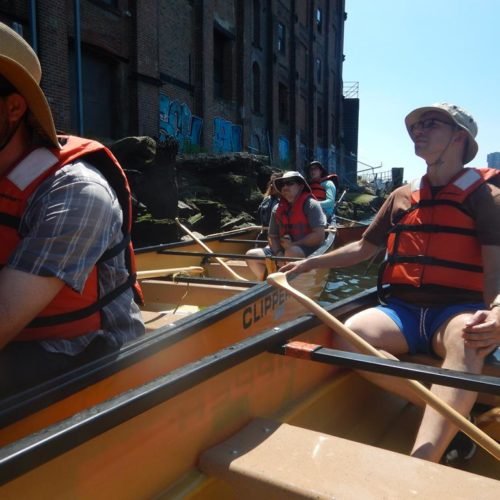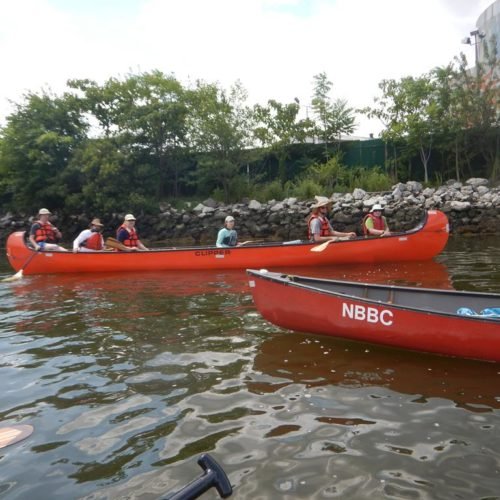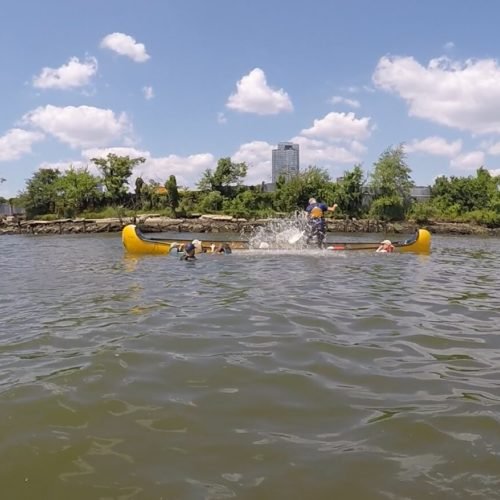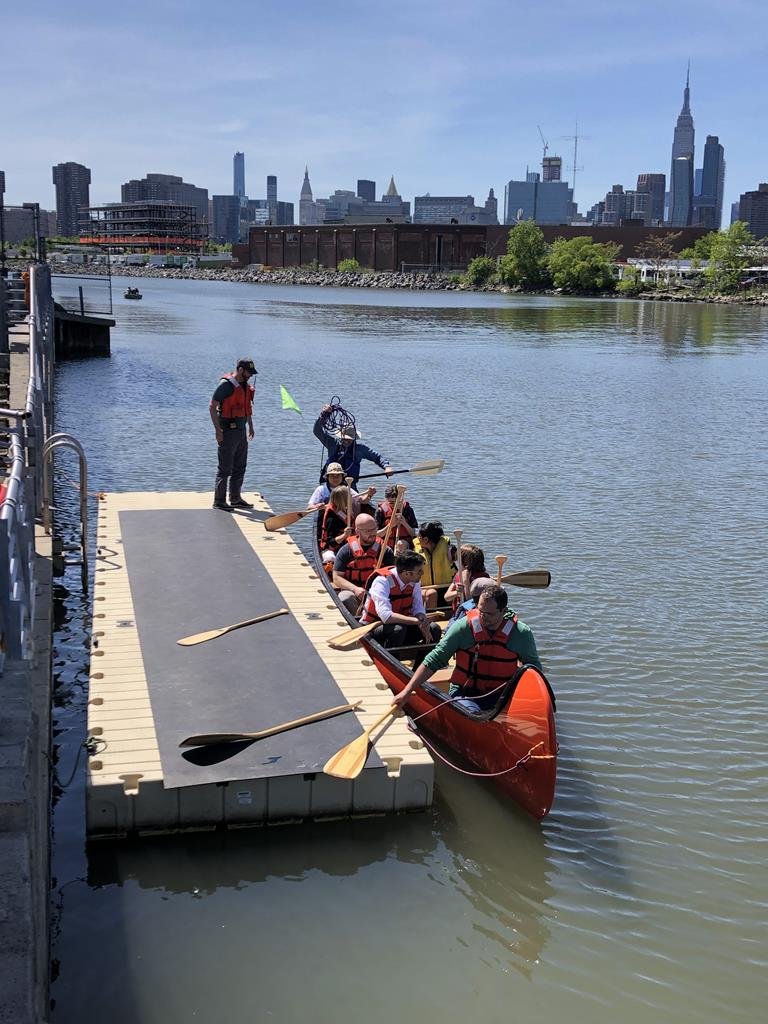Canoe News 2019
Scenes from the Big Canoe Training, July 2019
On the weekend of July 13-14, 2019, David Wooldridge of Ridge Wilderness Adventures led NBBC canoeists in the Big Canoe Skipper curriculum that he developed. The Langley canoes and this training were purchased with funds from NBBC’s GCEF grant. The boats have already proved invaluable for NBBC’s mission-critical public and educational programming. And the trip leaders and canoe volunteers who participated are eager to pass along the knowledge from this training to other NBBC member-volunteers.
Training in the new Langley canoes, Newtown Creek July 13, 2019. Dave lays it out.
Training in the new Langley canoes, Newtown Creek July 13, 2019. Morale takes a hit when rescue practice is put off till tomorrow ...
Training in the new Langley canoes, Newtown Creek July 13, 2019.
Training in the new Langley canoes, Bushwick Inlet, July 14, 2019
Training in the new Langley canoes, Bushwick Inlet, July 14, 2019. Rescue practice!
Training in the new Langley canoes, Bushwick Inlet, July 14, 2019. Dave uses Canadian curling techniques to bail the boat during rescues!
Training in the new Langley canoes, back on land at MASE Park, July 14, 2019. Everyone made it!
Come see the Langley canoes in action at our 2019 Public Paddle series!
And check out other great trips and events in the Paddle Gallery and Events Calendar.
This entry was posted in News, Photos, Voyages and tagged boatclub, canoe, Langleys, training, Voyageur on July 23, 2019 by M. H..
NBBC’s New Langley Canoes: A Transcontinental, International, Intensely Local Boat Story
Of Voyageurs and Voyages
In 2014, North Brooklyn Boat Club received a Greenpoint Community Environmental Fund grant for our Floating Classroom project. NBBC used this money to purchase our two Voyageur-style 25′ canoes.
Inscribed with the names of Newtown Creek’s former tributaries and terms from the tidal system of New York harbor, the Voyageur canoes took thousands of people onto the waters of Newtown Creek to learn about its history and ecology.
Floating Classroom landing at Dock
For five seasons, these boats were the foundation of our educational and public programming and critical to our ability to fulfill our mission. They were a crucial part of NBBC’s participation in a 2016 Earth Day action to protest the exclusion of indigenous peoples from the Paris Climate Accords, paddled by NBBC members and friends from indigenous tribes from around the world. The big canoes carried scouts and veterans, school kids and elders, NBBC members and our friends from other community organizations. They formed the hand we extended to our community, and we who paddled them came to love them.
But after five years, we realized that to continue our educational and public mission, it was necessary to upgrade the fleet. So when GCEF announced another round of grants for 2018, we applied to upgrade our educational facilities, including the boats of the Floating Classroom. When we received the GCEF grant award, the quest was on to find the best boats possible for our community mission.
After a great deal of research, we had a feeling that Western Canoeing and Kayaking, manufacturers of Clipper Canoes, was the best fit for what we do. So two NBBC member-volunteers decided that our responsibility to wisely spend the community funds that had been entrusted to us meant we should go see the manufacturer in person. And when you are going to Canada, why not make a paddle vacation out of the trip? So Michael and Patterson — members of the Canoe, Education, Boatyard, Communications, and Public Paddles Committees — announced a trip to do research on the canoe manufacturers (and paddling opportunities) of beautiful British Columbia. There, we went to the Western facility to meet the people who make Clipper Canoes.
(The junket — and mini-paddling-vacation weekend! — was entirely funded by Michael and Patterson; no club or grant money was spent.)
Yankees, Clippers
All Clipper Canoes, including the big ones, are made by hand, so we got to tour the actual factory floor where they are laid up. Western makes big canoes in many styles, from racing models to West Coast oceangoing craft. We met Lynne Smith, who has been with Western since 1977, and she graciously showed us every aspect of the making of Clipper Canoes and the showroom of completed models.
Clipper offers a wide range of styles in big canoes, in the Dancer Series of West Coast models as well as the Voyageur styles that we East Coast types are more familiar with. Lynne and Marlin Mayes, one of the founders of Western, talked us through the design of big Voyageur-style canoes and told us that the keeled, racing model we had been using was not the best for our purposes. They steered us toward the Langley, a 29′ canoe that can accommodate up to 14 paddlers (named after Fort Langley on the Fraser River, the “birthplace of British Columbia”). We realized that the Kevlar-and-gelcoat model would be much lighter than our Voyageurs, which required eight adults to move safely — a tall order for many of our education trips in the Floating Classroom.
Lynne showed us the ins and outs of the factory floor and boats in various stages of completion. She let us test the feel of completed boats in the showroom and demonstrated why Western’s philosophy calls for bucket seats and leg braces rather than bench seats and kneeling — another very East Coast vs. West Coast split in canoe thinking!
It’s hard to overstate how welcoming and generous Lynne, Marlin, and everyone at Western were to us. We felt like they respected our choice to come all the way to British Columbia to meet with them and see their facilities, and they honored that by showing us everything there was to see, from the Langley boats we ended up ordering to paddle accessories, tandem canoes, PFDs, and paddles, going over the function and differences among various models and helping us think through what would be best for the club and our public and education trips.
(And, like everyone else we met in British Columbia, when we told them our plan to go paddling in Squamish, everyone at Western — and everyone we met in Canada! — said, “It’s beautiful there! Gets a bit windy in the afternoon, though …”
We returned to New York convinced that Clipper’s Langleys were the way to go. We added three other tandem canoes for the club, including boats with three and four seats to maximize the flexibility of the fleet for education trips. (And then we agonized over our color choices, and Lynne had to talk us down from a few of our wilder ideas …) We also ordered a large assortment of paddles to go with the new fleet, including the club’s first set of bent-shaft paddles! By November, the order was placed, and then the waiting game began, a feeling familiar to every paddler who lives in a region with winters.
New Boats, New Season, Same Mission
Western sent the new boats and the rest of the order across the continent by train and then the final leg from New Jersey by truck. On a cold, drizzly morning in mid-April, several NBBC member-volunteers met in the early morning at the now-emptied boatyard at 51 Ash St. to unload the truck. By the end of April, the boats had been moved to our expanded dock. Where they sat and waited while the waters warmed …
With NBBC’s equipment scattered among exile locations, getting the new Langleys in the water for a test proved challenging. Finally, in conjunction with the May Steering Committee meeting, we got paddles wet and launched the boats in their new home waters, Newtown Creek.
That experience — seeing how four adults could shift the boats into the water, how easily they turned, how stably they rode—prepared us for the first real voyage of the new Langleys, our first Public Paddle of 2019!
Held out of the Manhattan Avenue Street End Park thanks to a fruitful partnership with NYC Parks, this was a true community event. The Public Paddles are NBBC doing what we do best: showing our neighbors that the waters are there for everyone and that new ways of seeing old sights unfold when paddling our great estuary.
The Public Paddles will continue all season. Even while in exile from the boatyard as we await construction of a permanent boathouse, NBBC will grow and develop our public and educational programming, just as we have done for more than seven years. We hope that by being out there on the water as often as we can, by showing our neighbors that we all have the right to be on the water, we will continue to kindle a sense of responsibility for the waterways that comes when you experience them firsthand, from close up, paddling a big canoe with friends and strangers and with YOUR community boat club.
*A Bit Windy in the Afternoon: Our Squamish Story
We spent two days in Squamish, one of the most beautiful towns either of us had been to. Like many towns in BC, it was once a logging and lumber transport center. Built on the peninsulas of a river delta at the top of Howe Sound, Squamish has water on three sides: an old shipping channel on the east, Howe Sound to the south, and the Squamish River to the west. Undaunted by the advice we received to get on the water by 5 AM, we launched onto the shipping channel at the crack of 11:30. All went well as we paddled out into the Sound, where we had to turn right and move out around the long dike of Spit Road, which stretches about half a mile from the mainland. We dodged a few sporty windsurfers, whose parachute-towed surfboards dotted the waters of the upper Sound. Feeling fairly confident, we rode the rising tide up the Squamish River until we found the going harder and harder against the current — even with the tide. (A lesson for paddlers used to the Hudson and New York Harbor: other rivers have real currents, and paddling against them will tire you out.) So after a lunch of very welcome sandwiches, we decided to head back down the now unfamiliar river (tides in Squamish can rise up to sixteen feet!). The main problem, though, was the 30+ m.p.h headwind blowing directly up the river…. Even with the current, we fought for every foot, and the freezing water poured in over the stem of the rental canoe, which seemed to channel it directly onto the bathing trunks of the bow paddler — though they dried just as fast in that wind! Going forward was working out for us, but that left turn to get back across the Sound loomed in our minds. Finally, we pulled over to the dike and hauled the canoe over the riprap and up onto Spit Road. We felt good about the decision and viewed the whole day as a success … especially when we learned that Squamish is one of the windsport capitals of North America!
So, yes, indeed, it’s beautiful there. But it gets a bit windy in the afternoon.
This entry was posted on May 16, 2019 by M. H..
Scenes from a Public Paddle
Now with more public!
NBBC’s 2019 Public Paddle Series launched Saturday, May 11, with our first community paddle activity wholly based in Manhattan Avenue Street End Park. Through the generous partnership of NYC Parks, we are able to launch our new fleet of 29′ canoes from the heart of Greenpoint and onto NBBC’s home waters on Newtown Creek.
Delivering the dock. NBBC member-volunteers needed to bring all supplies from other locations on Newtown Creek.
NBBC member-volunteers test out one of the new Langley canoes before the Public Paddle, May 11, 2019
Public Paddle, May 11, 2019
NBBC’s new 29′ Langley canoes made their first public trips, bringing more than a hundred people out on the waters of New York City and helping fulfill the mission of your community boat club.
Come join NBBC Saturday, May 25, for the next Public Paddle, and your city in a whole new way.
The 2019 Public Paddle Series at Manhattan Avenue Street End Park kicked off May 11.
This entry was posted on May 15, 2019 by M. H..






















